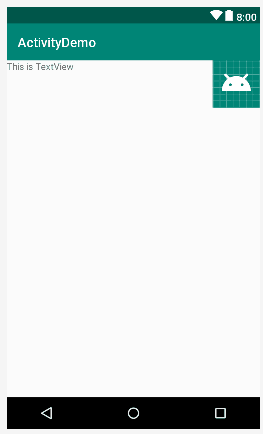FrameLayout又称作帧布局,他相比于LinearLayout和RelativeLayout要简单很多,因为它的应用场景也少了很多。这种布局没有方便的定位方式,所有的控件都会默认摆放在布局的左上角。
activity_main代码:
<?xml version="1.0" encoding="utf-8"?>
<FrameLayout xmlns:android="http://schemas.android.com/apk/res/android"
android:layout_width="match_parent"
android:layout_height="match_parent">
<TextView
android:id="@+id/tv"
android:layout_width="wrap_content"
android:layout_height="wrap_content"
android:text="This is TextView" />
<ImageView
android:id="@+id/iv"
android:layout_width="wrap_content"
android:layout_height="wrap_content"
android:src="@mipmap/ic_launcher" />
</FrameLayout>效果图:

可以看到,文字和图片都是位于布局的左上角。由于ImageView是在TextView之后添加的,因此图片压在了文字的上面。
当然除了这种默认效果之外,我们还可以使用android:layout_gravity属性来指定控件在布局中的对齐方式,这和LinearLayout中的用法是相似的。
修改activity_main.xml中的代码:
<?xml version="1.0" encoding="utf-8"?>
<FrameLayout xmlns:android="http://schemas.android.com/apk/res/android"
android:layout_width="match_parent"
android:layout_height="match_parent">
<TextView
android:id="@+id/tv"
android:layout_width="wrap_content"
android:layout_height="wrap_content"
android:layout_gravity="left"
android:text="This is TextView" />
<ImageView
android:id="@+id/iv"
android:layout_width="wrap_content"
android:layout_height="wrap_content"
android:layout_gravity="right"
android:src="@mipmap/ic_launcher" />
</FrameLayout>效果图:

总体来讲,FrameLayout由于定位的欠缺,导致它的应用场景也比较少,不过之后使用碎片的时候是可以使用到的。